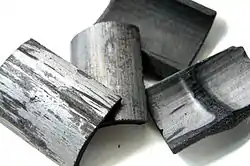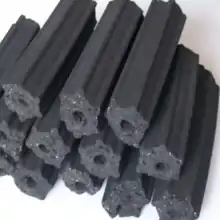Bamboo charcoal
Bamboo charcoal comes from pieces of bamboo plants, harvested after at least five years, and burned in ovens at temperatures ranging from 800 to 1200 °C. It benefits environmental protection by reducing pollutant residue.[1] It is an environmentally functional material featuring excellent absorption properties.[2]


Bamboo charcoal has a long Chinese history, with documents dating as early as 1486 during the Ming dynasty in Chuzhou Fu Zhi.[3] There is also mention of it during the Qing dynasty, during the reigns of emperors Kangxi, Qianlong, and Guangxu.[4]
Production
Bamboo charcoal is made of bamboo by means of a pyrolysis process. According to the types of raw material, bamboo charcoal can be classified as raw bamboo charcoal and bamboo briquette charcoal. Raw bamboo charcoal is made of bamboo plant parts such as culms, branches, and roots. Bamboo briquette charcoal is made of bamboo residue, for example, bamboo dust, saw powder etc., by compressing the residue into sticks of a certain shape and carbonizing the sticks. There are two equipment processes used in carbonization, one is a brick kiln process, and the other is a mechanical process.
In a bid to boost their town’s economy, a company based in Bayambang, Pangasinan, is set to go into large-scale charcoal making using bamboo.[5]
Uses
In China,Japan and Philippines many people use bamboo charcoal as cooking fuel, as well as to dry tea.[6] Most bamboo charcoal for fuel is bamboo briquette charcoal, and the rest is raw bamboo charcoal.[7] Like all charcoal, bamboo charcoal purifies water and eliminates organic impurities and smells.[8] It is possible to treat chlorine-sterilized drinking water with bamboo charcoal to remove residual chlorine and chlorides.[9] Because he and his team discovered the longevity of its use, Thomas Edison featured a carbonized bamboo filament in one of his original designs for the light bulb.[10]
Bamboo vinegar (called pyroligneous acid) is extracted during production, and is useful for hundreds of treatments in most fields. It contains about 400 chemical compounds and has many applications, including in cosmetics, insecticides, deodorants, food processing, and agriculture.
Some studies claim adding bamboo charcoal or bamboo vinegar to the diets of fish or poultry may increase their growth rates.[11]
Health hazards
As the World Health Organization shows, as with any charcoal, long exposure to bamboo charcoal dust can cause mild coughing. Some people have claimed it has positive effects as well but research has proven otherwise.[12]
Popular culture
Burger King is using bamboo charcoal as an ingredient in its cheese for its Kuro Burgers in Japan called the Kuro Pearl and Kuro Ninja burgers.[6]
References
- "Implementing strategy through projects". Long Range Planning. 28 (1): 133. February 1995. doi:10.1016/0024-6301(95)92150-8. ISSN 0024-6301.
- Huang, PH; Jhan, JW; Cheng, YM; Cheng, HH (2014). "Effects of carbonization parameters of Moso-bamboo-based porous charcoal on capturing carbon dioxide". Sci. World J. 2014: 937867. doi:10.1155/2014/937867. PMC 4147260. PMID 25225639.
- Yang, Yachang; Yu, Shi-Yong; Zhu, Yizhi; Shao, Jing (25 March 2013). "The Making of Fired Clay Bricks in China Some 5000 Years Ago". Archaeometry. 56 (2): 220–227. doi:10.1111/arcm.12014. ISSN 0003-813X.
- Air resource management : what we have been doing--. [Washington, D.C.?]: U.S. Dept. of Agriculture, Forest Service, Pacific Northwest Region. 1996.
- "DOST'S BAMBOOO CHARCOAL TECHNOLOGY HELPS PANGASINAN FIRM IN BAMBOO CHARCOAL MAKING". Department of Science and Technology, Government of the Philippines. 27 September 2017. Retrieved 26 October 2020.
 This article incorporates text from this source, which is in the public domain.
This article incorporates text from this source, which is in the public domain. - Dearden, L (2014). "Burger King launches black burger with 'bamboo charcoal cheese and squid ink sauce' in Japan". The Independent. Retrieved 15 January 2019.
- Mayer, Florian; Breuer, Klaus; Sedlbauer, Klaus, "Material and Indoor Odors and Odorants", Organic Indoor Air Pollutants, Weinheim, Germany: Wiley-VCH Verlag GmbH & Co. KGaA, pp. 165–187, ISBN 978-3-527-62888-9, retrieved 25 October 2020
- Riedel, Friedlind (25 November 2019), "Affect and atmosphere – two sides of the same coin?", Music as Atmosphere, [1.] | New York : Routledge, 2019. | Series: Ambiances, atmospheres and sensory experiences of spaces: Routledge, pp. 262–273, ISBN 978-0-8153-5871-8, retrieved 25 October 2020CS1 maint: location (link)
- Hoffman, F. (1 April 1995). "Retardation of volatile organic compounds in ground water in low organic carbon sediments". Cite journal requires
|journal=(help) - Matulka, R; Wood, D (2013). "The History of the Light Bulb". Energy.gov. US Department of Energy. Retrieved 15 January 2019.
- Low, YF (6 April 2009). "Bamboo charcoal can boost fish growth: study". The China Post. Taiwan. Archived from the original on 5 March 2012. Retrieved 11 March 2011.
- Lu, M (2007). "Bamboo charcoal may not be helpful". Taipei Times. Retrieved 17 April 2018.
External links
- Manual of Bamboo Charcoal Production and Utilization by Guan Mingjie of the Bamboo Engineering Research Center (BERC)
- Bamboo Charcoal – Information and How-to guide on making bamboo charcoal